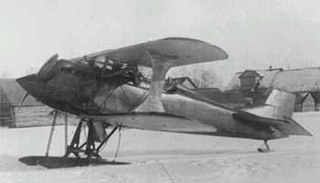Related Research Articles

The Grigorovich I-2 was a biplane fighter aircraft of the Soviet Union, the first indigenous fighter to enter service in substantial numbers. Developed from the Grigorovich I-1, it first flew on 4 November 1924, piloted by A.I. Zhukov. The M-5 engine was a Soviet copy of the Liberty L-12.

Grigorovich M-5 was a successful Russian World War I-era two-bay unequal-span biplane flying boat with a single step hull, designed by Grigorovich. It was the first mass production flying boat built in Russia.

Grigorovich M-9 was a Russian World War I-era biplane flying boat, developed from the M-5 by Grigorovich.

Grigorovich M-15 was a successful Russian World War I-era biplane flying boat, developed from the M-9 by Grigorovich.
Grigorovich M-16 was a successful Russian World War I-era biplane flying boat of the Farman type, developed from the M-9 by Grigorovich. Somewhat larger than the M-9, the M-16 was a version especially intended for winter operations, with better aerodynamic qualities.
The Lavochkin-Gorbunov-Gudkov LaGG-1 was a Soviet fighter aircraft of World War II. Although not very successful, it formed the basis for a series of aircraft that would eventually become some of the most formidable Soviet fighters of the war.
The Tupolev MTB-1 was a patrol flying boat built in the Soviet Union in the mid-1930s. It was a refined version of the unsuccessful Chyetverikov MDR-3. The revised design retained the MDR-3's hull, but added a newly designed, full-cantilever wing, a new tail, and a new engine installation featuring two tractor and one pusher unit. Trials began in March 1934 but the prototype was destroyed during one takeoff.

The Grigorovich IP-1 was a fighter aircraft produced in the Soviet Union in the 1930s. When the performance of both the Grigorovich I-Z and its single-shot Kurchevski DRP cannon armament proved disappointing, the development of that particular system did not halt development of the basic underlying concept of a cannon-armed bomber destroyer. Leonid Kurchevsky developed a new, 75 mm cannon designated the Kurchevski APK-4 which could fire five shots instead of just one, and once again the Grigorovich design bureau created an aircraft to carry it. The IP-1 was a conventional, low-wing cantilever monoplane with retractable tailskid undercarriage and an open cockpit. Construction throughout was all-metal, and like its predecessor, its horizontal stabiliser was mounted high to avoid gasses from the underwing cannons. Once again, however, trials proved the concept a failure.

The Grigorovich M-11 was a Russian single-seat fighter flying boat designed by Dmitry Pavlovich Grigorovich and built by Shchetinin
The MDR-3 (a.k.a.11) was a long-range flying boat designed and built in the USSR from 1931.
The Grigorovich MK-1 was a large trimotor floatplane, built and tested in Imperial Russia in 1916.
The Grigorovich MU-2 was a trainer flying boat built in the Soviet Union in the mid-1920s. It was designed by the Grigorovich Design Bureau after the failure of the Grigorovich MUR-1, featuring an all-metal hull. However, it was never put into production due to poor performance and sluggish take-off behavior.
The Grigorovich MUR-1,, was a trainer flying boat built in the Soviet Union in the mid-1920s.
The Grigorovich M-19 was a reconnaissance flying boat designed by Grigorovich in the late 1910s. The M-19 was a Grigorovich M-9 modified to be of the same size as the Grigorovich M-15. Assembly of the prototype was started in 1918, but the aircraft was not completed.
The Grigorovich M-23bis was a Soviet biplane flying boat built during the 1920s.
The Grigorovich ROM-1 was a long-range reconnaissance flying boat designed by the Grigorovich Design Bureau for the Soviet Navy in the late 1920s.
The Grigorovich ROM-2 was a long-range reconnaissance flying boat designed by the Grigorovich Design Bureau for the Soviet Navy in the late 1920s.
The Grigorovich MR-5 was a long-range reconnaissance flying boat designed by the Grigorovich Design Bureau for the Soviet Navy in the late 1920s.
The Grigorovich MR-2 was a long-range reconnaissance flying boat designed by the Grigorovich Design Bureau for the Soviet Navy in the late 1920s.
The Grigorovich MR-3 was a prototype maritime patrol flying boat built in the Soviet Union during the late 1920s that was not accepted for production.
References
- ↑ Шавров, В. Б. История конструкций самолётов в СССР до 1938. - М .: Машиностроение, 1988. ISBN 5-217-03112-3
- ↑ "MRL-1 by D.P.Grigorovich". Ram-home.com. 1998-07-28. Retrieved 2019-02-03.
- ↑ Gunston, Bill (1983). Aircraft of the Soviet Union : the encyclopaedia of Soviet aircraft since 1917. Osprey. p. 92. ISBN 978-0850454451.